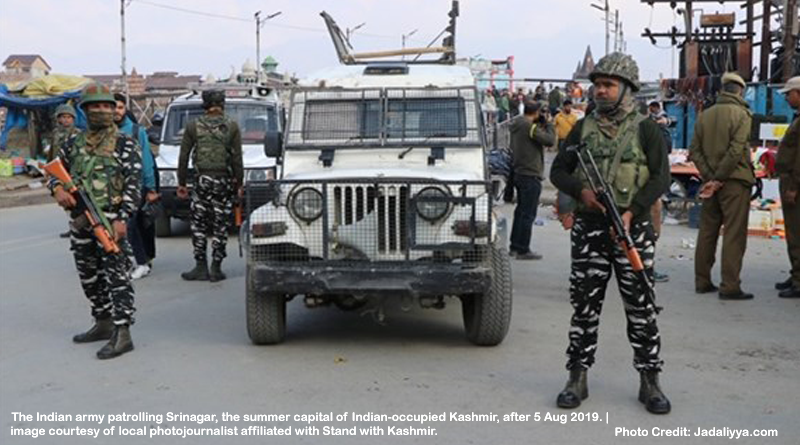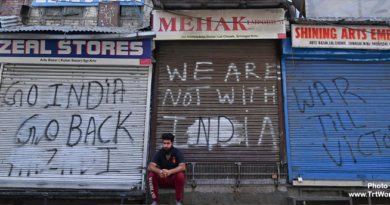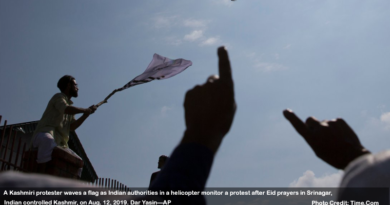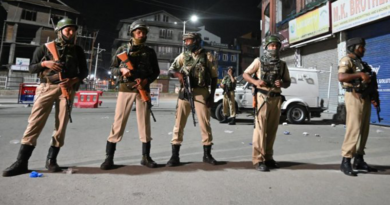The Violence on Kashmir Is Epistemological as It Is Physical
On 5 August 2019, the Indian government unilaterally changed the legal status of the state of Jammu and Kashmir. This measure not only undermined India’s own constitutional process, but also effectively annexed a territory that remains disputed in the international arena. Since then, the government has placed Indian-occupied Kashmir on lockdown, restricting the movement of reporters and human rights observers as well as a clamping down on communication infrastructure (including the internet and phone services). There have also been reports of widespread human rights abuses: extrajudicial detentions (including of minors); torture; sexual violence; and lack of access to basic medical and healthcare services.
The media establishment in India has overwhelmingly adopted both the historic discourse of the Indian state as well as that of its ruling BJP government. Yet there has been an unprecedented international outcry over the government’s recent actions. This is largely due to fears of an impending settler colonial project, as the revocation of Kashmir’s special status now enables people from India to buy land and property in Kashmir, and change the demographics of the Muslim-majority region.
Despite the striking clarity that India’s effective annexation of Kashmir provides relative to its longstanding colonial occupation, there still remain blind spots in academic and public discourses on Kashmir—especially within Indian liberal and leftist spaces. In what follows, I offer a critique of the dominant frames through which many self-identified liberal and leftist South Asian, and primarily Indian, academics have and continue to see Kashmir. It is imperative to change the basic frameworks and categories that have set up the debate on Kashmir thus far.
On Kashmir Being Complicated
Before 5 August, it was rare to find many institutions of higher education, including South Asian studies centers and departments, that held panels or discussions on Kashmir. Those that did usually featured statist perspectives or non-Kashmir experts. As a Kashmir scholar, it is frustrating to see the ways in which honest and empirically-grounded conversations on Kashmir rarely make it into our academic spaces. Particularly in short supply have been conversations that move beyond the India-Pakistan framework and center Kashmiri voices, perspectives, and aspirations.
Indeed, the violence on Kashmir is epistemological as it is physical, and there is a reinforcing relationship between the two. There is a complicity, largely on the part of many liberal and leftist Indian academics (and some of their Pakistani counterparts) in their invocations of the “complexity” or the “complicated” nature of Kashmir. On a personal level, I cannot begin to count the number of times I have asked senior academics why they do not engage with the question of Kashmir in their work on the Indian state, subaltern studies, postcolonial studies, partition studies, feminist studies, and so on.
I recall the Jawaharlal Nehru University (JNU) row some years ago, when academics around the globe mobilized and expressed their solidarity with the JNU students who were being charged with sedition. In a moment that perfectly captured the contradictions inherent in the Indian liberal project, the only voices apparently worth standing in solidarity with were those of the JNU students. Forgotten were the millions in Kashmir whose voices and aspirations have been muzzled for seventy-two years, and who were the main reason why the JNU row began in the first place.
This blindspot is simultaneously rooted in both a deep-seated allegiance to the “idea” of an Indian nation as well as a more sophisticated form of Islamophobia.
This blindspot is simultaneously rooted in both a deep-seated allegiance to the “idea” of an Indian nation as well as a more sophisticated form of Islamophobia. The latter not only continuously constructs the bogey of Pakistan, erasing any form of Kashmiri agency, but also engages in a majoritarian impulse of being completely unable to apprehend, and thereby dismiss, Muslim political aspirations. Let us be frank: Kashmir is “complicated” because it is a Muslim-majority space, and many liberals and leftists alike cannot bear to contend with that reality.
Consequently, the differentiation between many of the Indian secular/liberal intelligentsia and proponents of Hindu nationalism—especially on the question of Islam or Kashmir—is not so variegated. It relies on the same tropes, the same processes of othering, and the same inability to see beyond a nationalist impulse. As the scholar Nosheen Ali argues, “The racist, castiest, and irredentist fabric of Indian society is invisible in a secular-on-top-savarna-underneath national discourse in which Muslims are the problem populace, and Kashmir, to be subdued at all cost.”
On Indian Democracy
While things may be starting to change, especially given the challenges that the Hindutva project poses to this idea of India as a pluralistic, democratic space, there remains a romanticism about India before Modi—or even before Hindutva began to gain traction in the past few decades. Fundamentally, the Kashmir question today, and the revocation of Article 370, is not about India’s democratic or legal institutions being undermined or under threat. It is, however, a culmination of India’s long-standing colonial occupation of Kashmir, one that has taken various forms over the past seventy-two years. As Kashmir studies scholar Goldi Osuri argues, “the first phase of this occupation was the contested accession to India, the second phase was the immense militarization of the region—which remains the most militarized in the world—and bringing in laws that give the Indian army complete impunity for their actions in Kashmir, then the third phase will be marked by a full-on settler colonial project.”
Aside from the families associated with the client regimes of the Indian government, Kashmir’s Muslim-majority did not maintain any allegiance to or nostalgia surrounding Article 370. Kashmir’s “special status,” enshrined in the article, was built on the understanding between the Indian leadership and its client state in Kashmir that integration to India would be a hard sell for the vast majority of Kashmiris after partition. Over time, the article remained one on paper. Kashmiris—and here I use Kashmiri as a political identity, not solely an ethnic one—knew that the autonomy that had been promised to them had eroded over time, as the Indian state entered into all aspects of political, economic, legal, and civic life in Kashmir—well beyond the officially-sanctioned domains of communications, foreign affairs, and defense.
The legality or illegality of the revocation then is not the primary framework from which most Kashmiris see these developments. They know all too well how the law in Kashmir has served as a critical component of the military occupation through acts like the Armed Forces Special Powers Act (which provides complete impunity to the armed forces in Kashmir) and the Public Safety Act (what Amnesty International has referred to as a “lawless law,” as it allows the preventive detention of people, including children, against whom there is no criminal offense).
Why there is rage, however, is related to another article of the Indian constitution: Article 35A. This article gave the local Kashmiri state the right to define requirements for permanent residency in the state. Permanent residents were exclusively able to own property or buy land in Kashmir. This was a condition that the pro-accession local leadership insisted upon to protect Kashmir’s Muslim-majority status, and was the last thing Kashmiris were holding onto to preserve some semblance of their nationhood. But the 5 August revocation has now changed this. Indians can now buy property and land in Kashmir, and drive out the indigenous population. Thus, what is at stake in this move is the beginnings of a settler-colonial project in Kashmir.
To be sure, the over 700,000-strong deployment of the Indian military already populated the land. This apparatus had taken over huge swaths of land with their cantonments, camps, and bunkers. But now the ruling BJP can set in motion its long-term plan to populate the region with enough Hindu settlements to make obsolete the current Muslim majority’s political aspirations for freedom. Indeed, while the Indian government maintains that the article was revoked to further integrate Kashmir into India, enable development, and curb “terrorism,” a recent clip of the Indian consul-general in New York City exemplifies the settler-colonial logic at play. In the clip, the consul-general calls for the implementation of the Israeli model in Kashmir. The intent here is to change the demographics of Kashmir from a Muslim-majority state to one that has a Hindu majority. This process could entail ethnic cleansing. This is why, for Kashmiris, this is an existential moment—one of life and death.
One also cannot help but wonder why fear of undermining democratic institutions has been a rallying cry for those who protest the abrogation. For Kashmiris, India has never been a democracy. It was not a democracy when the early Indian leadership, including its first post-independence Prime Minister Jawaharlar Nehru, suppressed the demand for a UN-backed plebiscite, installing a series of client regimes that were tasked with securing the contested accession for India. It was certainly not a democracy when during the 1950s and through the 1970s, these client regimes began to repress pro-plebiscite and pro-Pakistan movements in Kashmir, invoking colonial-era draconian laws prohibiting association and speech. Popular forms of dissent were framed as “anti-national, seditious, and subversive.” It was not a democracy when the Indian National Congress-led governments rigged elections in Kashmir in the late 1980s, eventually leading to armed rebellion. And it is certainly not a democracy today, as we mark over 120 days of siege against eight million people, depriving them of internet and restricting phone lines, while also detaining and torturing many of them—including children as young as eleven years of age.
The tragedy of Kashmir is not a reflection of the erosion of Indian democracy. It is a product precisely of the sham of Indian democracy: its irresolvable contradictions; violent majoritarianism; and pernicious secularity that thrives on quashing minority lives in the name of liberal pluralism. Any perspective that valorizes the territorial frame of the Indian nation-state insidiously suffocates the possibility of alternate political futures and horizons unimprisoned by the idea of India. It is precisely such an absence of political imagination that nourishes the tendency to view Indian atrocities in Kashmir primarily through the prism of the threat they pose to other Indian states and populations— as a whole host of analysis did after 5 August.
In this slippery slope argument, the critique of the Indian state is invariably couched in the language and imperative of “saving Indian democracy” from itself, of preventing others parts of India from becoming Kashmir. We must note the way this framing both instrumentalizes Kashmir in the service of rescuing India from its own majoritarian pitfalls, at the same time it shackles Kashmir to the project of “improving Indian democracy.” I repeat: Kashmir has never been a part of India, it’s people never gave consent to India’s rule over them, it is not a laboratory of Indian democracy, and it is not a litmus test of India’s alleged promise of secular equality. The vast majority of Kashmiris desire and demand complete freedom from the territory, idea, and promise of India in all its manifestations and apparitions.
To posit the question of Kashmir as one of Indian federalism—meaning that if only the center could figure out the appropriate degree of control it wants to hold over the various states—is misguided at best and intellectually dishonest at worst. Consider the perspective of one scholar in the BBC: “The single biggest significance of this move is that we are moving towards a unitary state, and abrogation of democratic principles. This is weakening federalism in India. People are so busy celebrating the move that they don’t seem to get the big picture.” This position simply reiterates the Indian state’s talking point that the question of Kashmir is one of governance rather than sovereignty.
One cannot engage with the question of Kashmir without also acknowledging that Kashmir had a historic popular anti-feudal and anti-monarchical struggle for sovereignty well before 1947. The claims and longer histories of the people of this region, who existed before India and Pakistan emerged as post-colonial nation-states have been ignored. Kashmir is not like other regions of India, because no other region in India has numerous UN resolutions that stake claim to its disputed status under international law. The provisional status of Kashmir’s contested accession to India marks it as a different case altogether from other regions.
I want to briefly turn to another source of liberal and left anxiety about Kashmir: Islam. It is hard to escape the fact that liberal and left anxieties about Kashmir have much to do with Islam—and this has pre-dated the post-2001 war on terror. That it is anti-secular, violent, and uniquely misogynist—all of these claims and tropes are harnessed and deployed against the Kashmiri struggle. They work to undermine any kind of nuanced discussion—leave alone solidarity—with the Kashmir movement. That is not to dismiss the ways that the war on terror has been crucial in shifting the ground. Undoubtedly, the Indian state has perniciously used the war on terror logic to undermine the movement for self-determination. As Zunaira Komal notes, those “Kashmiris engaged in jihad against the state’s occupation, have had their Islamic framework of physical and moral struggle labeled and collapsed under the global phantasm of “terrorism” a tactic that is strategically deployed by the global war on terror beneficiaries to disenfranchise Islamic anti-colonial movements.” What we need to understand is the ways in which Islam is simultaneously spectacularized and erased within the logic of the War on Terror. Komal continues that “taking seriously the moral universe being espoused in such aspirations would necessitate a nuanced hermeneutic sensitive to the moral discourse of Islam which challenges the very notion of secular freedom itself.”
Conclusion
We, as scholars, students, and concerned individuals must stake an ethical position on the question of Kashmir—one that engages with this oft-repeated refrain of what do Kashmiris really want. Ending the Indian occupation and giving Kashmiris a right to self-determination is truly the only ethical position one can take on Kashmir. Understandings that simply focus on improving governance, reinstating Article 370, or addressing the human rights violations, fail to get to the root of what is at stake. Any solution must of course take into consideration the aspirations of all regions and communities of the former princely state. Here, I think it is important to note, as the anthropologist Mona Bhan has argued, the state of Jammu and Kashmir’s diversity (religious, linguistic, and ethnic) is held up as evidence of the intractable nature of political divides in the state. It is only the Kashmiri speaking Sunni Muslims of the Kashmir Valley who demand azadi (freedom), the argument goes. What about everyone else? Bhan argues that this difference from Kashmiri Muslims is used to frame the Kashmiri struggle for self-determination as parochial and territorially limited in order to render it morally and politically illegitimate. She asks whether those who speak on behalf of these communities “know what it means to live on the border, on the state’s margins, to be asked to offer their lives, land and resources to maintain India’s security and territoriality. “ Furthermore, as the editors of Resisting Occupation in Kashmir argue, “the diversity of the state has been heavily policitized through selective patronage and regional biases in development and governance mechanisms, a policy that local governments have actively pursued to fragment communities in order to stall Kashmir’s political resolution and perfect the colonial strategy of divide and rule.”
Therefore, foregrounding and resolving Kashmir enables us to think of aspirational futures of the subcontinent beyond the India vs. Pakistan binary and beyond Hindu-Muslim divides. Perhaps it will allow us to foresee a future for South Asia beyond the nation-state paradigm. Azadi for Kashmir will mean azadi for Pakistan, for India, and for the region as a whole.
[This article is based on presentations given at the “Article 370 and its Aftermath” and “Kashmir: Article 370 and Beyond” panel events, held at Columbia University and New York University, respectively, in September 2019. A video of the author’s Colubmia University presentation can be viewed here.]
Courtesy:
https://www.jadaliyya.com/Details/40341
Author:
Hafsa Kanjwal is an assistant professor of South Asian history at Lafayette College. She received her PhD from the University of Michigan, Ann Arbor in History and Women’s Studies. Her research focuses on post-partition state-building in Indian-occupied Kashmir. She has written and spoken on Kashmir for a variety of news outlets including The Washington Post, Al Jazeera English, and the BBC. She is a founding member of the Critical Kashmir Studies collective, an academic collaborative that promotes research and scholarship on Kashmir.




